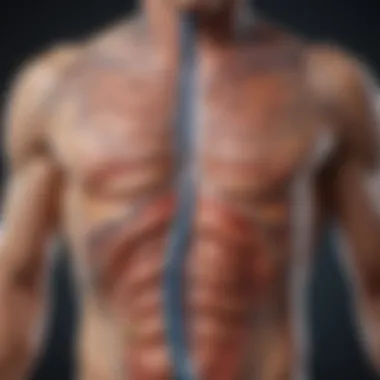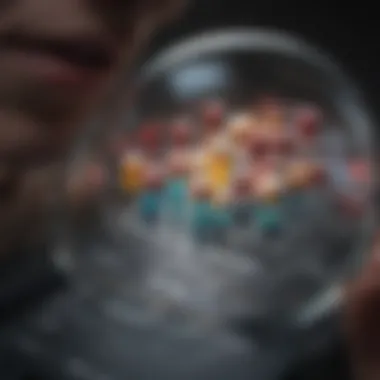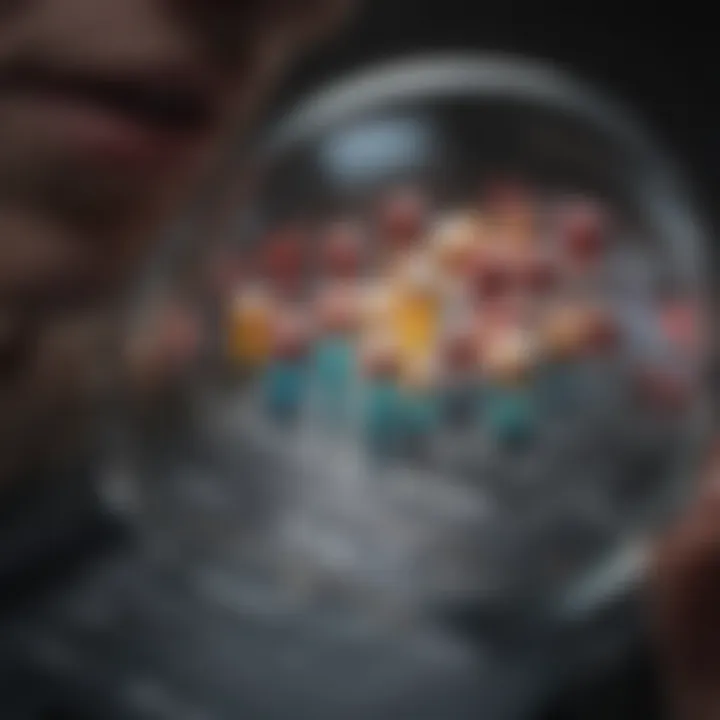High Bilirubin Treatment: Causes and Management Strategies


Intro
High bilirubin levels in the bloodstream can be a cause for concern. Understanding what leads to this condition is crucial for effective management and treatment. Bilirubin, a yellow substance produced during the normal breakdown of red blood cells, can indicate underlying health issues such as liver dysfunction or hemolysis when present in excessive amounts. This article seeks to examine the causes, implications, and management strategies for elevated bilirubin levels, providing a detailed understanding of this important health topic.
Research Overview
Understanding the complexities surrounding high bilirubin levels requires a thorough investigation into various methodological approaches employed in research.
Methodological Approaches
Research in this area predominantly involves clinical studies and laboratory analyses that observe patients with elevated bilirubin. Common approaches include:
- Cross-sectional studies: These studies help capture the prevalence of high bilirubin levels in different populations.
- Longitudinal studies: Following patients over time to assess changes in bilirubin levels and disease progression offers insights on causality.
- Randomized controlled trials: These are crucial for evaluating the efficacy of treatments and interventions.
Significance and Implications
The significance of studying high bilirubin levels lies in its potential for revealing serious health issues. Early detection can lead to timely medical interventions, possibly preventing complications related to liver disease or hemolytic disorders. Moreover, understanding how bilirubin synthesis and elimination works can inform lifestyle modifications that aid in managing and optimizing bilirubin levels.
Understanding elevated bilirubin levels is essential for preventing severe health complications and promoting well-being.
Current Trends in Science
The field of bilirubin research has experienced significant developments. Innovative techniques and tools are continuously being integrated into clinical practice.
Innovative Techniques and Tools
Recent advancements include:
- Non-invasive imaging techniques: Tools like MRI and ultrasound improve the assessment of liver function and bile duct obstructions.
- Biochemical analysis: Advanced blood tests provide a more detailed profile of liver function and bilirubin metabolism.
Interdisciplinary Connections
Researchers are increasingly recognizing the importance of interdisciplinary collaboration. This involves not only medical professionals but also biochemists and geneticists. Such cooperation can result in enhanced understanding and better treatment of conditions associated with high bilirubin levels.
By comprehensively exploring these elements, this article aims to shed light on the intricacies of high bilirubin treatment, offering a well-rounded perspective for students, researchers, educators, and professionals involved in health sciences.
Preface to Bilirubin
Bilirubin is a critical biochemical marker that reflects several physiological processes in the body, particularly those related to the liver. Understanding bilirubin and its implications is fundamental when discussing high bilirubin levels. This section aims to provide insight into the definition and function of bilirubin, as well as the metabolic processes that govern its concentration in the bloodstream.
Definition and Function
Bilirubin is a yellow compound formed during the breakdown of hemoglobin in red blood cells. As these cells age, they are removed from circulation. The hemoglobin within them is converted into bilirubin, which undergoes a series of transformations in the liver.
The primary function of bilirubin lies in its role as a waste byproduct. It helps the body eliminate excess hemoglobin, and its levels in the bloodstream can indicate how effectively the liver is processing waste. Elevated levels may signal underlying issues, such as liver disease or hemolytic disorders.
Bilirubin Metabolism
The metabolism of bilirubin consists of multiple steps. First, once formed, bilirubin is transported to the liver. Here, it is converted from its unconjugated form, which is fat-soluble and potentially harmful, to a conjugated form that is water-soluble.
This transformation allows the bilirubin to be excreted into bile, which then reaches the intestines for elimination in feces. It is crucial to maintain a balance; excessive bilirubin can lead to conditions like jaundice, which occurs when the liver cannot process it efficiently.
Proper bilirubin metabolism not only helps in detoxification but also supports the body’s overall metabolic health. Any disruptions in this process can lead to significant health implications, highlighting the need for a thorough understanding of bilirubin's role within the body.
Understanding High Bilirubin Levels
Understanding high bilirubin levels is crucial in both clinical and personal health contexts. High bilirubin concentrations can signal serious underlying health issues, necessitating timely diagnosis and intervention. Elevated levels can result from various factors, which makes exploring them essential for effective management strategies. Comprehensive knowledge about bilirubin metabolism, its normal ranges, and potential causes of elevation is necessary for both healthcare providers and patients.
Normal Bilirubin Levels
Normal bilirubin levels typically range from 0.1 to 1.2 milligrams per deciliter (mg/dL) in adults. These levels can vary based on factors such as age, health status, and whether the individual has any liver conditions. Maintaining bilirubin levels within this normal range is essential as it reflects proper liver function and overall health. When levels exceed this range, it may indicate liver dysfunction or other systemic issues.
Causes of High Bilirubin
High bilirubin levels can arise from a multitude of conditions and factors. Identifying the root cause is pivotal in determining the appropriate treatment and management plan. Here are several of the primary contributors to high bilirubin levels:
Genetic Disorders
Genetic disorders, such as Gilbert's syndrome, play a significant role in bilirubin metabolism. Individuals with Gilbert's syndrome have a deficiency in the enzyme responsible for processing bilirubin. This leads to an accumulation of unconjugated bilirubin in the bloodstream. The benefit of recognizing this condition is its usually benign nature, but it can still result in elevated bilirubin levels.
Unique to genetic disorders is their hereditary nature, which allows for family-wide implications. Educating patients on this factor enhances awareness and promotes early detection and management strategies for those potentially affected.
Liver Diseases
Liver diseases, especially hepatitis, cirrhosis, and liver cancer, directly affect bilirubin processing. The key characteristic of liver diseases is their ability to disrupt normal hepatic function, leading to increased levels of both conjugated and unconjugated bilirubin.
Understanding liver diseases is crucial because they can have profound effects on overall health, necessitating immediate intervention. The unique feature of these diseases is their tendency to show additional symptoms, such as fatigue, abdominal pain, and jaundice, providing clear clinical signs that warrant focused diagnostic efforts.
Medication Effects
Certain medications can inadvertently raise bilirubin levels as a side effect. Drugs such as acetaminophen and some antibiotics can cause hepatotoxicity, leading to disrupted bilirubin metabolism. The key strength of recognizing medication effects lies in the ability to modify or adjust treatment regimens accordingly.


Understanding how medications influence bilirubin levels is valuable for clinicians in managing patient care. Patients need to be informed about potential side effects of their medications which can lead to unexpected elevations in bilirubin.
Hemolytic Anemia
Hemolytic anemia is characterized by the premature destruction of red blood cells, which releases additional hemoglobin that is broken down into bilirubin. This increased breakdown can overwhelm the liver's capacity to process bilirubin effectively. The notable aspect of hemolytic anemia is that it often comes with symptoms like fatigue and pallid skin, making it easier to identify.
The unique feature here is the rate of destruction of red blood cells; patients may require different management approaches based on severity. Understanding the dynamics of hemolytic anemia is important, as it allows for tailored treatment strategies to manage both the anemia and the resulting high bilirubin levels.
By understanding the various causes of high bilirubin, proactive steps can be taken in treatment and lifestyle adjustments.
Diagnosis of High Bilirubin
Diagnosing high bilirubin levels is critical in understanding and managing this condition effectively. Elevated bilirubin can signal various underlying health issues, making accurate diagnosis essential. Timely identification enables healthcare providers to address the root causes and initiate appropriate treatment strategies. Patients and healthcare professionals both benefit from knowing when and how to investigate bilirubin levels, enabling better health outcomes.
Blood Tests
Blood tests are the primary method for diagnosing high bilirubin levels. These tests measure the total bilirubin in the blood, including both direct and indirect bilirubin.
Regular blood tests can help identify not only elevated levels but also the specific type of bilirubin that is high.
Key types of blood tests include:
- Total Bilirubin Test: Measures overall bilirubin levels.
- Direct Bilirubin Test: Assesses water-soluble bilirubin, which can indicate liver function issues.
- Indirect Bilirubin Test: Measures the non-water-soluble fraction, often elevated in hemolytic anemias.
Additionally, high levels of bilirubin might show up in routine check-ups, making it important for individuals to keep up with regular health screenings. \n
Though blood tests can be accurate, they do not provide comprehensive insights into the cause. For this reason, many doctors recommend additional diagnostic techniques following an initial blood test indicating high bilirubin levels.
Imaging Tests
Imaging tests are essential for visualizing the liver and biliary system, helping to identify potential causes of elevated bilirubin. These non-invasive methods can reveal structural abnormalities, blockages, or liver damage.
- Ultrasound: This is often the first imaging test performed. It helps identify obstructions in bile ducts and assesses liver size.
- CT Scan: A computed tomography scan offers detailed images of the liver and surrounding organs, providing clarity on any lesions or abnormalities.
- MRI: Magnetic resonance imaging may be employed for a more thorough evaluation, particularly of soft tissue structures or tumors.
These imaging studies are vital in guiding the next steps in management and determining if further tests or treatments are necessary.
Liver Biopsy
In some cases, when other diagnostic methods are insufficient, a liver biopsy may be performed. This procedure involves extracting a small liver tissue sample for examination. This test can help determine the underlying cause of high bilirubin levels more accurately.
Indications for a liver biopsy include:
- Persistently elevated bilirubin levels despite normal imaging results.
- Suspected liver disease such as cirrhosis, hepatitis, or fatty liver disease.
While a liver biopsy can provide valuable diagnostic insights, it is also invasive and comes with potential risks such as bleeding or infection. Therefore, it is usually considered only when the potential benefits outweigh these risks.
"Diagnostics are not just about finding what is wrong; they are the first steps towards comprehensive management and treatment."
Symptoms Associated with High Bilirubin
Understanding the symptoms associated with high bilirubin is crucial. High bilirubin levels often signal underlying health issues. Identifying these symptoms allows individuals to seek medical attention promptly. It also aids in preventing possible complications. Here are three common symptoms related to high bilirubin levels:
Jaundice
Jaundice is perhaps the most recognized symptom of high bilirubin. This condition leads to yellowing of the skin and eyes. The yellow discoloration occurs due to the accumulation of bilirubin in the bloodstream. In some cases, jaundice can be subtle. In others, it can be quite pronounced. The severity of jaundice often correlates with bilirubin levels.
Additionally, jaundice is not merely cosmetic; it indicates that there might be something seriously wrong. Conditions such as liver diseases, hemolytic anemia, or bile duct obstruction can cause jaundice. Monitoring this symptom is essential. It signifies that a medical evaluation is necessary to determine the root cause.
Dark Urine
Dark urine is another significant indicator of elevated bilirubin levels. When bilirubin is processed by the liver but not properly excreted, it can end up in the urine. This causes the urine to take on a darker color, often resembling tea or cola.
The presence of dark urine suggests that bilirubin is spilling into the urinary system. This can occur due to issues like liver dysfunction or the breakdown of red blood cells. Patients noticing dark urine should pay attention, as it often signifies that further investigations are needed.
Pale Stools
Pale stools can also signal an issue with bilirubin levels. Normally, bilirubin gives stool its characteristic brown color. If bilirubin levels are high and impediments obstruct its flow to the intestines, stools may appear pale or clay-colored.
Pale stools often indicate the need for medical investigation. They can signify bile duct obstruction or serious liver disease. It is essential for individuals experiencing pale stools alongside other symptoms to consult a healthcare provider.
Elevated bilirubin can manifest through jaundice, dark urine, and pale stools. Recognizing these symptoms early can lead to timely medical intervention.
Treatment Options for High Bilirubin
The management of high bilirubin levels is crucial for improving patient outcomes. This section discusses both conventional medical treatments and lifestyle modifications. Each method serves a unique purpose, targeting either the underlying causes or the symptoms associated with elevated bilirubin. Understanding these options allows patients and healthcare practitioners to make informed choices.
Conventional Medical Treatments
Conventional medical treatments form the cornerstone of managing high bilirubin levels. They typically involve specific medications and procedures designed to address the root causes effectively.
Medication
Medications aimed at lowering bilirubin levels can be vital in certain conditions. For instance, drugs like phenobarbital can help stimulate the liver's ability to excrete bilirubin. This medication is known for its effectiveness in treating persistent jaundice, especially in newborns.
One key characteristic of medication used for high bilirubin is its targeted action. These medications can offer rapid relief but may have side effects. Some patients might experience sedation or allergic reactions. Overall, medications provide a beneficial choice when rapid intervention is required.


Phototherapy
Phototherapy represents another significant treatment. This method primarily utilizes blue light to convert bilirubin into a water-soluble form that the body can eliminate more easily. Non-invasive and effective, phototherapy is particularly popular for treating newborns with jaundice.
A unique feature of phototherapy is its ability to reduce bilirubin levels quickly. However, it may require ongoing sessions, depending on the severity of the condition. Side effects like skin rash or dehydration can occur but are generally manageable. Thus, phototherapy remains a beneficial approach, particularly in neonatology.
Exchange Transfusion
In severe cases of hyperbilirubinemia, an exchange transfusion might be necessary. This procedure involves removing a portion of the patient’s blood and replacing it with donor blood to quickly lower bilirubin levels. This method is often used in cases of hemolytic disease of the newborn.
The key characteristic of exchange transfusion is its immediate impact on bilirubin levels. However, it is an invasive procedure and carries risks, including infection or electrolyte imbalance. Thus, while effective, it is generally considered a last resort.
Lifestyle Modifications
While medical treatments play a central role, lifestyle modifications also contribute significantly. These changes can enhance medical interventions or serve as standalone strategies.
Dietary Changes
Making dietary changes is essential for managing bilirubin levels. A diet low in fat and rich in fruits and vegetables can support liver function, helping to lower bilirubin. It emphasizes foods that are nutrient-dense and limit processed foods, which may augment liver stress.
Unique to dietary changes is their ability to provide a holistic approach to treatment. Patients may find it challenging to stick to new dietary habits, but the long-term benefits outweigh these difficulties. Overall, dietary adjustments are a beneficial addition to treatment plans.
Hydration
Hydration plays a critical role in maintaining optimal liver function. Drinking enough water helps the kidneys efficiently flush out bilirubin and other toxins. It's a simple yet effective remedy to support various bodily functions.
One unique feature of hydration is its low risk profile; it is a natural remedy that usually has no side effects. Patients should be mindful, though, of taking too much sodium, which can counteract benefits. Nevertheless, maintaining adequate hydration is crucial for proper management.
Avoiding Alcohol
Avoiding alcohol is another vital lifestyle choice for anyone dealing with high bilirubin levels. Alcohol is known to damage liver cells, exacerbating bilirubin levels and impairing the body's ability to process it adequately.
The key characteristic of this approach is its preventative nature. Abstinence from alcohol allows the liver to recover, thereby aiding in bilirubin management. One downside is the social aspect—many find it difficult to abstain, especially in social settings. However, the advantages of better liver health and lower bilirubin levels deeply justify this choice.
In summary, both conventional medical treatments and lifestyle modifications are essential for managing high bilirubin levels. They provide a broad range of options that can support liver health and overall well-being.
Long-Term Management of Bilirubin Levels
Effectively managing high bilirubin levels requires a long-term approach that addresses both monitoring and treatment of underlying causes. Long-term management is critical because persistent high bilirubin can indicate ongoing health issues. Untreated conditions can lead to severe complications and deteriorate patient health over time. Understanding the various aspects of managing bilirubin levels can empower patients and healthcare providers to take proactive steps toward maintaining optimal health.
Regular Monitoring
Monitoring bilirubin levels is essential for individuals diagnosed with elevated levels. Regular blood tests help track changes in bilirubin concentration, providing insights into one’s overall liver function and health status. People with known liver diseases, such as cirrhosis or hepatitis, might require frequent monitoring to detect early signs of worsening conditions or complications. One benefit of routine monitoring is early intervention; sudden spikes in bilirubin levels might prompt a reassessment of treatment strategies. Moreover, keeping a log of blood test results can aid both patients and healthcare providers in identifying trends over time.
Key Points on Regular Monitoring:
- Identification of Trends: Understanding whether bilirubin levels are stable or rising over time.
- Prompt Reaction: Allows for timely interventions in case of sudden changes.
- Informed Decisions: Helps tailor treatment plans based on individual needs.
Overall, monitoring plays a pivotal role in effectively managing bilirubin levels and ensuring that any underlying conditions are adequately addressed.
Managing Underlying Conditions
Managing the root causes of high bilirubin is just as important as monitoring levels. Treating conditions like liver disease or hemolytic anemia can significantly impact bilirubin levels. For instance, individuals with chronic liver issues may require specific medications to improve liver function, whereas those with hemolytic anemia might need therapies to address blood cell destruction.
Some crucial strategies for managing underlying conditions include:
- Medications: Targeted treatments like antiviral drugs for hepatitis.
- Lifestyle Changes: Healthy diet and avoiding alcohol can help improve liver health.
- Regular Consultations: Continuous dialogue with healthcare professionals to track progress and adjust treatments as needed.
"By managing underlying conditions effectively, patients can ensure that bilirubin levels remain within a healthy range, promoting better overall health and reducing the risk of complications."
When to Seek Medical Attention
Recognizing when to seek medical attention for high bilirubin levels is crucial. It not only aids in timely intervention but can also prevent more severe health issues. High bilirubin can indicate underlying conditions that may require immediate medical attention. Understanding the signs and circumstances that warrant a visit to a healthcare provider is essential for effective management and treatment of bilirubin elevation.
Signs of Severe Bilirubin Elevation
Some signs indicate a significant increase in bilirubin levels that requires urgent care. These include:
- Jaundice: A yellowing of the skin and eyes is often the most noticeable sign. This occurs when bilirubin builds up in the bloodstream beyond normal levels.
- Severe Fatigue: An unusual level of tiredness that does not improve with rest can be a sign of serious underlying liver issues.
- Nausea and Vomiting: Such symptoms may accompany a rise in bilirubin levels, especially if linked to liver dysfunction or hemolysis.
- Abdominal Pain: Significant discomfort, especially in the upper right quadrant, may suggest liver inflammation or gallbladder issues.
- Dark Urine: The presence of dark urine is typically indicative of excess bilirubin in the body.
If any of these symptoms are present, immediate consultation with a healthcare professional is advisable. Early diagnosis can facilitate effective treatment and mitigate potential complications.
Emergency Situations
Certain conditions require urgent medical attention when experiencing high bilirubin levels. These emergencies may include:
- Acute Liver Failure: Symptoms like confusion, severe jaundice, and profound abdominal swelling can be warning signs.
- Severe Anemia: Acute hemolytic reactions might present with rapid heart rate, shortness of breath, and significant weakness; such symptoms are critical.
- Biliary Obstruction: Signs could include intense abdominal pain, fever, and dark urine.
- Infections: Symptoms of a systemic infection might include high fever and chills., which can complicate the underlying cause of bilirubin elevation.
In such situations, quick action is necessary. Delays can lead to heightened risks, including permanent damage to the liver or other organs.
Seeking medical attention promptly can make a substantial difference in managing high bilirubin levels effectively.


Potential Complications of High Bilirubin
High bilirubin levels can indicate more than just a simple health issue; they can result in significant complications if left unaddressed. Understanding the potential risks helps individuals recognize the importance of timely diagnosis and appropriate treatment. Elevated bilirubin can signify underlying liver disease or hemolytic disorders, both of which may have serious repercussions for overall health.
Liver Damage
One of the most serious complications associated with high bilirubin levels is liver damage. When bilirubin levels are high, this may mean the liver is not functioning properly. Conditions such as hepatitis, cirrhosis, or fatty liver disease can cause an increased bilirubin accumulation. Liver damage can lead to severe health consequences, including liver failure, requiring more extensive treatments.
- Early Detection: Monitoring bilirubin levels regularly can catch liver issues early, improving treatment outcomes.
- Reversible Damage: Some liver damage can be reversed if action is taken promptly. Following medical advice and adopting healthy habits is crucial in these cases.
Impact on Quality of Life
High bilirubin levels can significantly affect an individual’s quality of life. Symptoms like jaundice, fatigue, and itching can lead to physical discomfort. Psychological factors such as anxiety and depression can develop due to the stress of living with an ongoing medical condition or the fear of severe health implications.
- Physical Symptoms: Jaundice, characterized by yellowing of the skin and eyes, can impact self-image and social interactions.
- Daily Activities: Fatigue and discomfort may limit a person’s ability to participate in routine activities, leading to a withdrawal from social life.
Complications from high bilirubin are not merely clinical; they extend to emotional and social aspects. Addressing these issues requires a comprehensive management strategy that includes medical treatment as well as emotional support from healthcare providers and loved ones.
"Early intervention in cases of high bilirubin is key in preventing these complications and ensuring a better quality of life for affected individuals."
Awareness of these potential complications can motivate individuals to seek timely medical advice, ultimately leading to better management of their health.
Preventative Measures
Preventative measures are essential in managing high bilirubin levels, as they can reduce the risk of health complications related to liver dysfunction and other underlying conditions. By adopting specific lifestyle choices and regular health assessments, individuals can better maintain their bilirubin levels within a normal range. This proactive approach not only aids in early detection of potential issues but also contributes to overall health and well-being.
Healthy Lifestyle Choices
Making informed decisions about one’s diet and physical activity is a significant step towards preventing high bilirubin levels. Here are several key lifestyle practices:
- Balanced Diet: Consuming a diet rich in fruits, vegetables, whole grains, and lean proteins can support liver health. Foods such as leafy greens, berries, and avocados provide essential vitamins and antioxidants. Avoiding processed foods and those high in sugar and fats can help maintain a healthier liver.
- Regular Exercise: Engaging in physical activity helps maintain healthy body weight and improves overall metabolic functions. Regular workouts can enhance liver function and decrease the likelihood of developing liver-related diseases that might raise bilirubin levels. Aim for at least 150 minutes of moderate exercise each week.
- Hydration: Ensuring adequate fluid intake is crucial for liver detoxification. Staying hydrated aids in flushing out toxins from the body, which can help prevent complications related to high bilirubin levels.
- Avoiding Alcohol: Consuming alcohol in moderation or abstaining altogether is vital for liver health. Excessive alcohol intake can lead to liver damage and elevated bilirubin levels.
Routine Health Check-Ups
Regular health evaluations are a cornerstone of preventative healthcare. They can aid in early identification and intervention of potential health issues before they progress. Consider the following aspects of routine check-ups:
- Blood Tests: Periodic blood tests to monitor liver function and bilirubin levels are crucial. These tests provide valuable insights into liver health, enabling timely management if levels are abnormal.
- Professional Assessment: Regular visits to healthcare providers allow for a thorough assessment of medical history, risk factors, and lifestyle influences on health. Providers can offer personalized advice for managing bilirubin levels effectively.
- Vaccination: Staying updated on vaccinations, particularly for hepatitis A and B, can prevent liver diseases that may impact bilirubin levels.
By prioritizing healthy lifestyle choices and committing to routine health check-ups, individuals can take significant steps toward managing their bilirubin levels and enhancing their overall health.
A proactive approach to health, including lifestyle modifications and regular assessments, serves not only to manage bilirubin levels but also to promote quality of life.
Recent Research and Advances
Recent developments in the understanding and treatment of high bilirubin levels offer significant hope for improving patient outcomes. This section highlights the advancements in emerging therapies and innovative diagnostic techniques. As research continues to evolve, it becomes crucial to stay informed about these developments. They not only enhance our understanding of bilirubin management but also provide effective tools for healthcare professionals and patients alike.
Emerging Therapies
Recent investigations into therapies targeting elevated bilirubin levels have shown promise. One important area of focus is the use of gene therapy for inherited disorders leading to high bilirubin. For example, conditions such as Gilbert’s syndrome and Crigler-Najjar syndrome may benefit from gene editing techniques that correct genetic mutations responsible for bilirubin metabolism. These therapies aim to restore normal function and minimize bilirubin elevation through precise alterations at the genetic level.
Moreover, new pharmacological agents are being researched to enhance hepatic uptake and conjugation of bilirubin. Drugs such as bilirubin glucuronidase inhibitors could potentially reduce unconjugated bilirubin levels. These treatments are in different stages of clinical trials, offering exciting possibilities for future applications.
Despite the promise, there are key considerations. Implementation of emerging therapies necessitates thorough clinical validation and monitoring for side effects. The long-term effects of these treatments need to be assessed across diverse patient populations to ensure safety and efficacy.
Innovative Diagnostic Techniques
The diagnosis of high bilirubin levels is evolving, driven by technological advancements. Innovative techniques in imaging and biomarkers are improving the accuracy of diagnoses. One notable advancement is the development of non-invasive imaging methods such as elastography and advanced ultrasound techniques. These methods can assess liver function and structure without the need for potentially harmful invasive procedures, which can deter some patients from seeking help.
Additionally, the application of metabolomics in bilirubin disorders allows clinicians to identify unique metabolic profiles associated with various conditions. This technique can lead to earlier diagnosis and more tailored treatment plans. Furthermore, the integration of artificial intelligence in diagnostic imaging is enhancing interpretation capabilities, leading to faster and more accurate decisions regarding patient care.
Overall, these innovative diagnostic techniques not only improve the understanding of bilirubin metabolism but also facilitate timely interventions. As these technologies develop, it is essential for healthcare professionals to adopt them into practice for improved patient outcomes.
Staying updated with recent research is instrumental in forming effective management strategies for high bilirubin levels. Engaging with new studies can guide healthcare professionals in choosing the most appropriate treatments.
Closure
Understanding high bilirubin levels is essential for recognizing potential health risks. This article highlights the significant implications of elevated bilirubin, particularly regarding liver dysfunction and hemolytic anemia. The discussion emphasizes the need for timely diagnosis and appropriate management strategies, which can vary from lifestyle changes to sophisticated medical treatments.
The benefits of addressing high bilirubin levels cannot be understated. Early intervention can prevent complications such as liver damage and can improve an individual's quality of life. Educating patients and healthcare providers about the causes, symptoms, and treatment options fosters a proactive approach to health, ultimately leading to better health outcomes.
Moreover, it is vital that individuals understand their bilirubin levels in the context of their overall health. Regular monitoring through blood tests can help detect abnormalities early. The multifaceted nature of bilirubin metabolism highlights the importance of continued research to discover new treatment options and to refine existing ones.
Summary of Key Points
This article provided a comprehensive overview of several key elements:
- The definition and functions of bilirubin
- The normal bilirubin levels and causes for their elevation
- Diagnostic approaches used to ascertain bilirubin levels
- Symptoms indicating high bilirubin
- Treatment options encompassing both medical and lifestyle modifications
- Long-term management strategies and the importance of regular monitoring
- A range of potential complications that can arise from untreated high bilirubin
- Preventative measures to maintain healthy bilirubin levels
- Recent advancements in research related to bilirubin treatment
These points underscore the necessity for ongoing dialogue and research into bilirubin's role in human health.
Future Directions in Treatment
Future directions regarding the treatment of high bilirubin levels involve both technological advancements and a deeper understanding of genetic influences on bilirubin metabolism. The development of emerging therapies holds promise for more effective interventions.
Research into innovative diagnostic techniques is crucial. These methods can facilitate earlier detection of high bilirubin levels and related conditions. Collaboration among researchers, healthcare professionals, and patients will enhance treatment approaches.
Additionally, a focus on personalized medicine is emerging. Understanding the genetic factors that contribute to high bilirubin levels may lead to tailored treatments that address individual needs.
Keeping abreast of current studies and trials will also be vital. Continued funding for research in this area can lead to breakthroughs in both treatment and prevention strategies. This holistic focus will improve our capability to manage bilirubin-related health issues effectively.



